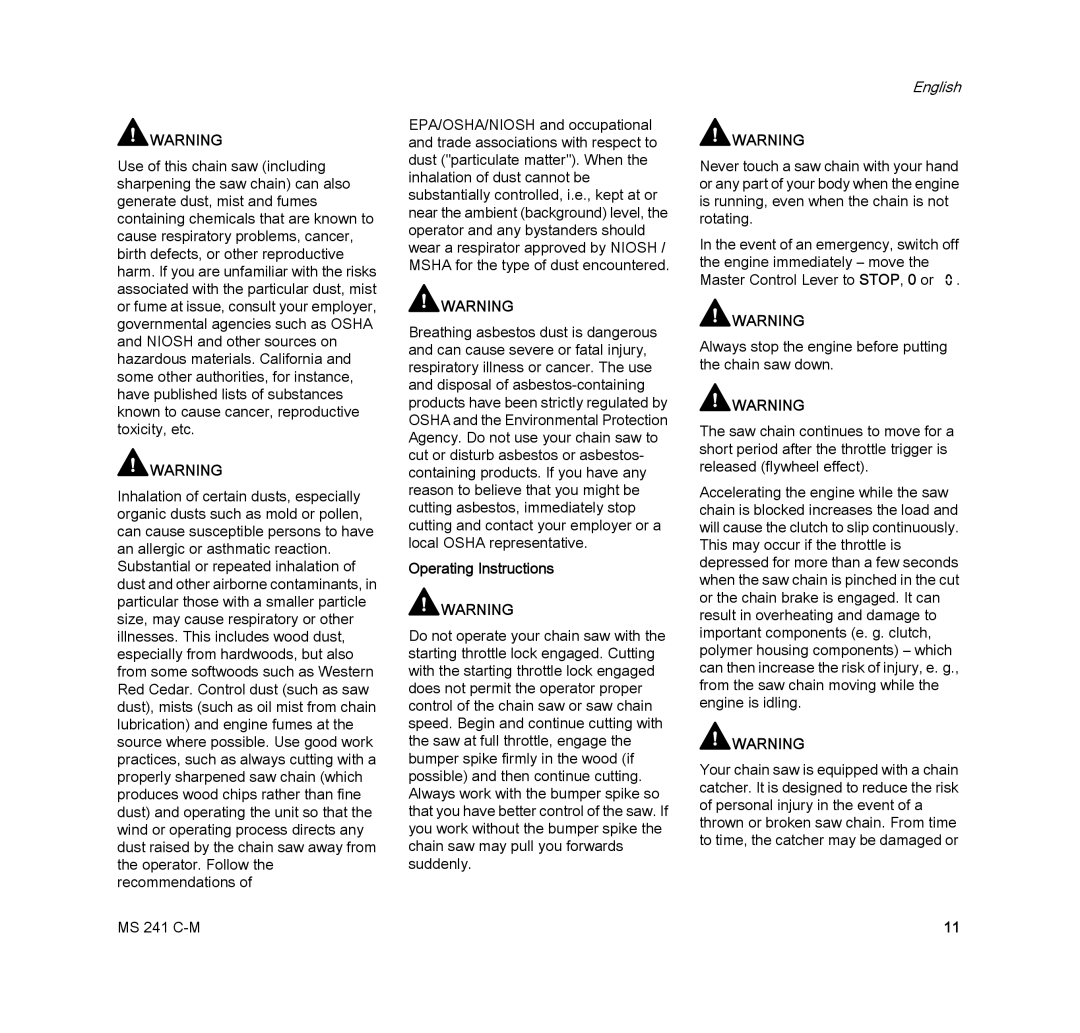![]() WARNING
WARNING
Use of this chain saw (including sharpening the saw chain) can also generate dust, mist and fumes containing chemicals that are known to cause respiratory problems, cancer, birth defects, or other reproductive harm. If you are unfamiliar with the risks associated with the particular dust, mist or fume at issue, consult your employer, governmental agencies such as OSHA and NIOSH and other sources on hazardous materials. California and some other authorities, for instance, have published lists of substances known to cause cancer, reproductive toxicity, etc.
![]() WARNING
WARNING
Inhalation of certain dusts, especially organic dusts such as mold or pollen, can cause susceptible persons to have an allergic or asthmatic reaction. Substantial or repeated inhalation of dust and other airborne contaminants, in particular those with a smaller particle size, may cause respiratory or other illnesses. This includes wood dust, especially from hardwoods, but also from some softwoods such as Western Red Cedar. Control dust (such as saw dust), mists (such as oil mist from chain lubrication) and engine fumes at the source where possible. Use good work practices, such as always cutting with a properly sharpened saw chain (which produces wood chips rather than fine dust) and operating the unit so that the wind or operating process directs any dust raised by the chain saw away from the operator. Follow the recommendations of
MS 241
EPA/OSHA/NIOSH and occupational and trade associations with respect to dust ("particulate matter"). When the inhalation of dust cannot be substantially controlled, i.e., kept at or near the ambient (background) level, the operator and any bystanders should wear a respirator approved by NIOSH / MSHA for the type of dust encountered.
![]() WARNING
WARNING
Breathing asbestos dust is dangerous and can cause severe or fatal injury, respiratory illness or cancer. The use and disposal of
Operating Instructions
![]() WARNING
WARNING
Do not operate your chain saw with the starting throttle lock engaged. Cutting with the starting throttle lock engaged does not permit the operator proper control of the chain saw or saw chain speed. Begin and continue cutting with the saw at full throttle, engage the bumper spike firmly in the wood (if possible) and then continue cutting. Always work with the bumper spike so that you have better control of the saw. If you work without the bumper spike the chain saw may pull you forwards suddenly.
English
![]() WARNING
WARNING
Never touch a saw chain with your hand or any part of your body when the engine is running, even when the chain is not rotating.
In the event of an emergency, switch off the engine immediately – move the Master Control Lever to STOP, 0 or †.
![]() WARNING
WARNING
Always stop the engine before putting the chain saw down.
![]() WARNING
WARNING
The saw chain continues to move for a short period after the throttle trigger is released (flywheel effect).
Accelerating the engine while the saw chain is blocked increases the load and will cause the clutch to slip continuously. This may occur if the throttle is depressed for more than a few seconds when the saw chain is pinched in the cut or the chain brake is engaged. It can result in overheating and damage to important components (e. g. clutch, polymer housing components) – which can then increase the risk of injury, e. g., from the saw chain moving while the engine is idling.
![]() WARNING
WARNING
Your chain saw is equipped with a chain catcher. It is designed to reduce the risk of personal injury in the event of a thrown or broken saw chain. From time to time, the catcher may be damaged or
11
